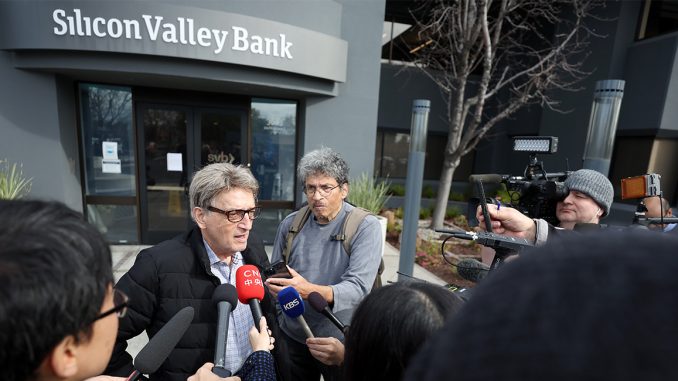
After one of the biggest banks in the technology startup lending space collapsed last week, President Joe Biden tried to reassure Americans that their banking system was still safe. But if bank examiners are not doing their job, which was the fundamental problem in the Silicon Valley Bank crash, then customers’ deposits are not safe.
Bank documents also seem to indicate that corporate leadership may have been more interested in things like environmental sustainability, climate change, and diversity initiatives than risk management.
On Monday, Biden said, “Today, thanks to the quick action of my administration over the past few days, Americans can have confidence that the banking system is safe.”
But all laws, including the Dodd-Frank Act that reformed banking laws, are worthless if there is no enforcement mechanism from bank examiners on banks to reduce risk.
Consider that Silicon Valley Bank had no chief risk officer between April 2022 and January 2023. Its Risk Committee had no members experienced in risk management. This is no way to run a bank—especially one that invests in high-risk tech startups.
The U.K. Parliament dealt with this dereliction scenario by passing a Senior Managers’ and Certification Regime in 2013 and applied it to the banking sector in 2016. U.K. law places personal responsibility on top executives. It is a criminal offense to make a decision that leads to the failure of an institution, with penalties of unlimited fines and/or up to seven years in prison.
Left to their own devices, if there are no consequences, banks will take unnecessary risks with depositors’ funds. But not with their own funds: Silicon Valley Bank CEO Gary Becker sold $3.6 million in shares two weeks before the crash, netting a profit of $2.3 million, and other board officers also sold shares this year.
If the government is going to bail out banks, it must enforce existing laws to keep them solvent. For example, the Federal Reserve should not allow banks to run big bond investment portfolios without requiring them to record profits and losses daily.
While neglecting critical risk management, the bank’s 2023 proxy statement records 40 mentions of the environmental, social, and governance—or ESG—movement currently in vogue at many corporations and financial institutions.
In a “key change,” the board expanded the Governance and Corporate Responsibility Committee’s oversight role in ESG.
The committee’s oversight includes, according to the proxy statement, “environmental sustainability, climate change, the Company’s external diversity, equity and inclusion (“DEI”) initiatives, Board diversity, as well as our philanthropic strategy and advocacy activities.”
This shows a misplaced sense of priorities. The four members of the Governance and Corporate Responsibility Committee (including Garen Staglin, who operates a Napa Valley winery) were among the six members of the Risk Committee. In retrospect, more time devoted to the Risk Committee would have been advisable.
Reasonable people might assume that the San Francisco bank examiners would look over the books and ask about risk management—especially for a bank that specialized in lending to high-risk Silicon Valley startups. But there is no record of concern from bank examiners about the bank’s mix of assets and liabilities.
It’s clear that the bank should not have been holding risky bonds in its liquidity portfolio, and a bank examiner with initiative would have questioned this strategy. The bank was investing client deposits in liquid bonds but had chosen higher-risk bonds whose value fluctuated significantly when interest rates rose and fell. When customers withdrew deposits, as they did when they needed cash for their startups, the bank needed to sell bonds, crystallizing losses.
The values of short-term, less risky bonds rise and fall less relative to fluctuating interest rates. If Silicon Valley Bank had bought three-month bonds or left their cash with the Federal Reserve’s Overnight Reverse Repo Facility, the bank would not have lost capital value. But these bonds have lower yields and could have been less attractive to inexperienced bank officials for that reason.
Members of the bank’s Risk Committee had little risk management experience and did not know enough to get an experienced risk assessment team on board.
The bank invested its deposits in higher-interest long-term securities whose prices changed more dramatically than short-term bonds as the Fed raised interest rates. The higher interest rates are how it could pay half a percent more on deposits than other banks.
At the same time, values of Silicon Valley tech firms were falling. This was an imprudent decision that the Risk Committee and bank examiners should have caught.
This should encourage the Fed to move steadily to raise interest rates a quarter of a percent at a time, rather than jumping to half a percent when its Board of Governors meets next week. As Chair Jerome Powell made clear last week, the Fed is serious about reducing inflation. A steady stream of small increases generally keeps markets happier than unpredictable increases.
Much newspaper ink will be spilled over whether America needs a new set of banking laws; whether Uncle Sam should bail out small banks; and whether a Federal Deposit Insurance Corporation infusion of capital, as was given to Silicon Valley Bank over the weekend, constitutes a bailout.
But laws such as Dodd-Frank cannot work if they are not enforced. America doesn’t need more laws. It needs existing laws to be taken seriously.
Have an opinion about this article? To sound off, please email letters@DailySignal.com, and we’ll consider publishing your edited remarks in our regular “We Hear You” feature. Remember to include the URL or headline of the article plus your name and town and/or state.

